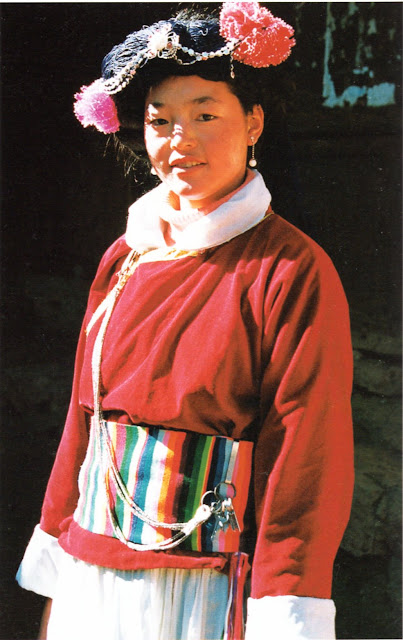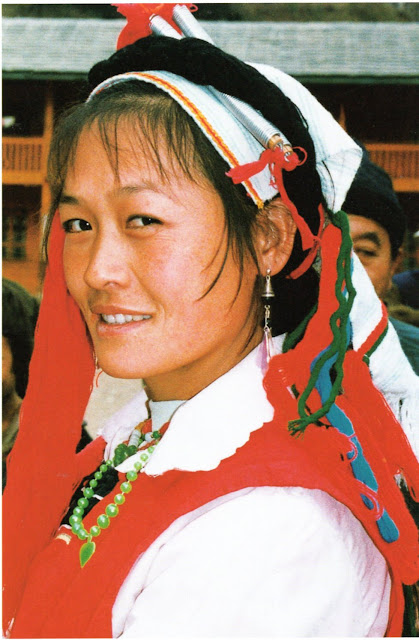Hello all,
Today I will start talking about some of the peoples who speak Sino-Tibetan languages who are neither Han Chinese, Tibetan, nor Bamar [Burman]. These are the three great branches of the Sino-Tibetan language family, but there are several others, and the experts do not agree as to how they relate to each other. Most of these people inhabit the current Chinese Empire, but some also inhabit the neighboring countries of Vietnam, Laos, Thailand and Myanmar.
I will try to group them by language families. There are many small groups which are not officially recognized. There are too many to cover them all.
Tujia Branch
Tujia
The Tujia language forms a unique branch of this language family, with two very distinct dialects. The image at the head of the article is of a Tujia family from Yongshun county in Hunan province. The Tujia number over 8 million.
https://en.wikipedia.org/wiki/Tujia_people
This map shows the location of the Tujia homeland within China, at the intersection of the provinces of Hubei, Hunan, Chongking and Guizhou. In the southern part of this territory they are neighbors of some of the Miao. The large silver headdresses are similar to those worn by some Miao girls.
This video shows some snippets of Tujia culture.
https://news.cgtn.com/news/3d3d514d7841444d35457a6333566d54/index.html
One famous part of Tujia culture is the Baishou, or hand-waving dance.
https://www.youtube.com/watch?v=UnGcBKJFCIo
https://www.youtube.com/watch?v=yF32jijLyQ4
Qiangic Branch
The Qiangic languages are spoken on the edge of Tibetan Ethnic territory, mostly in central Sichuan and northern Yunnan provinces. There are in about 20 languages, but not all of these groups are considered to be distinct official minority peoples by the Chinese government, but are lumped in with Tibetans and other recognized groups.
https://en.wikipedia.org/wiki/Qiangic_languages
Qiang
The Qiang live in northern Sichuan, between the Tibetans to the west and the Han and other peoples to the east. They number about 300,000, and speak a number of dialects, many of which are not mutually intelligible. They do elaborate embroidery, including cross stitch, which is not done by the Chinese, but by various peoples in the southwest of the Chinese Empire. An important part of their costume is the sheepskin vest.
https://en.wikipedia.org/wiki/Qiang_people
Naxi
The Naxi , also called Nakhi or Nashi, people number about 300,000, and live in south central Sichuan, in the Liangshan area, and northwest Yunnan. The most notable element of the costume is a sort of mantle made of sheepskin with 7 rosettes on the back. This is tied around the shoulders.
https://en.wikipedia.org/wiki/Naxi_people
The following images are from Naxi communities in Sichuan.
Mosuo
The Mosuo are lumped in with the Naxi by the Chinese government, but both peoples disagree with this. The Mosuo are found by Lake Lugu in northern Yunnan, and are also found in southern Sichuan. They number about 40,000, and call themselves the Na. They
are famous for the institution of 'walking marriage'.
https://en.wikipedia.org/wiki/Mosuo
There is a community of Mongols in this region, who, while they remember their origins, have become assimilated into the culture of the Mosuo.
This girl is dressed in Mosuo type costume, but the boy is dressed in Tibetan costume.
Pumi
The Pumi people also live in northwestern Yunnan and Southern Sichuan, especially around Lanping. They number perhaps 40,000. Their dress is similar to that of nearby peoples.
https://en.wikipedia.org/wiki/Pumi_people
This map shows the Pumi in Sichuan.
This map shows the Pumi in northwestern Yunnan. They are depicted in yellow with diagonal cross hatching.
Again, this boy is dressed in the Tibetan style.
Nungish Group
This branch of the Sino Tibetan language family is of uncertain affiliation within the family. There are three main languages, Derung, Nu, and Rawang, which are spoken in extreme northwestern Yunnan, and across the border in northern Myanmar.
https://en.wikipedia.org/wiki/Nungish_languages
Derung
This group inhabits a compact area in northwestern Yunnan on the Myanmar border. The main characteristic of the costume is a striped mantle which is worn by both men and women. They number about 6,000. Here is the map of northwest Yunnan. The Derung or Dulong people are represented by gray vertical hatching.
https://en.wikipedia.org/wiki/Derung_people
Religious observances include animal sacrifice. The meat is then shared out between all present.

This is a very rugged and remote area.
If you look at the map of northwest Yunnan, the Nu are represented by the brown areas near the Derung. They are mostly surrounded by the Lisu. There are about 27,000 Nu. The costume is characterized by the use of linen.
https://en.wikipedia.org/wiki/Nu_people
Rawang
The Rawang live in northern Kachin State in Myanmar, just over the border from the Derung and Nu. They are usually lumped in with other groups in the area as Kachin by the Burmese government. The colorful stripes are also present in the costumes of these people. https://en.wikipedia.org/wiki/Rawang_language
You can see their area in this map, which shows the Derung, Nu, Lisu, etc. The Nu are here labeled as the Nung and the Nusu. The line is the border between the northernmost part of Myanmar and the Chinese Empire, with Yunnan on the right, Tibet to the North, and the easternmost part of Assam, India, on the left.
Bai Group
Bai
The Bai language is usually considered to be a separate branch of the Sino-Tibetan language family with just one language. The Bai people number over two million, and live in the northwestern part of Yunnan, south of the peoples mentioned above. They love the color white, and have a long history in the area. You will see a few different types of costume. It is the Bai people, not the Chinese, who sometimes use cormorants for fishing.
https://en.wikipedia.org/wiki/Bai_people
Here we see that some of the northern Bai have costumes similar to those of the neighboring Naxi.
Here is a Bai orchestra wearing formal performance clothing, likely derived from Han court clothing.
Here we see the old style headdress on the left, with wonderful cross stitching, and the new style on the right, on the daughter, with different embroidery. often punch needle.
This concludes part one of this series.
Thank you for reading, I hope that you have found this to be interesting and informative.
Roman K
email: rkozakand@aol.com
Source material:
China Travel and Tourism Press, 'Ethnic Festivals and Costumes of Sichuan', 2004
China Travel and Tourism Press, 'Ethnic Festivals and Costumes of Yunnan',
Deng Qiyao et al, 'The Folk Arts of Yunnan Ethnics',
Bernard Formoso, 'Costumes du Yunnan', Nanterre, 2013
Shan Ren et al, 'The Cream of Yunling - A Photo Odyssey of Yunnan Ethnic Groups', Kunming, 1998















































































































































No comments:
Post a Comment